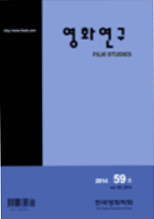- 영문명
- A Study on New Characteristics of Japanese Films in the 1960s∼1970s: Focusing on Antithesis Trend of Tradition in 4 Directors
- 발행기관
- 한국영화학회
- 저자명
- 전평국
- 간행물 정보
- 『영화연구』제53호, 269~307쪽, 전체 39쪽
- 주제분류
- 예술체육 > 예술일반
- 파일형태
- 발행일자
- 2012.09.30
7,480원
구매일시로부터 72시간 이내에 다운로드 가능합니다.
이 학술논문 정보는 (주)교보문고와 각 발행기관 사이에 저작물 이용 계약이 체결된 것으로, 교보문고를 통해 제공되고 있습니다.

국문 초록
영문 초록
This study considered a research on new trend of Japanese films in the 1960s∼1970s focusing on 4 directors. Like the West, even Japan was in the era of a whirlpool politically and socially enough to have it as 'one turning point of paradigm' with entering the 1960s. Four directors violently shake the whole of terrain in Japanese film with 'new wave,' calling even a film as old generation, with new challenge and innovation standing against the period before it. These directors proceed with making their films with new form, style and theme while fighting with the existing order, politics, and ideology with revolting against the tradition of Japanese film. Oshima Nagisa, who led the new-wave movement, proceeded with pursuing development in a film with new theme, new assertion, and new method while fighting with traditional film most combatively and innovatively. Imamura Shohei pioneered aesthetics called Imamura realism with inquiring into a problem about 'what is Japanese style'(Japanese identity), by firmly maintaining attitude dubbed 'spirit of denegation,' through challenging Mizoguchi's tradition & emotion, and aestheticism & universal humanism value. Suzuki Seijun took the lead in vitality of Japan's popular culture with cultish popularity by making a film of standing for decadence and aestheticism with experimental form and destructive informality in the limit of genre, with odd and unique video and style. And Yamada Yoji proceeded with opening new chapter of Japanese film with humor and wit on a petit bourgeois's fragmentary thought about life even while proceeding with continuing the consistent material, character, and story writing technique by displaying 'artisan spirit' within the film-making system peculiar to Japan. These films, which are expressed with 'vitalism,' are greatly differentiated from their original works in young & energic hero, in strongly social-criticism element through sex and violence, in negation of humanism and sentimentalism, in a mixed form of using documentary style, in looseness & open composition in the structure of story, and in radical experiment of a form and contents. The Japanese films following the 1960s∼1970s amid this trend come to develop into the so-called 'diversification' and 'internalization' era by creating films in diverse genres and forms such as commercial & art films, experiment, documentary, and animation with many challenges and responses in the middle of the affiliation and cooperation system of major company and independent production.
목차
1. 서론
2. 오시마 나기사(大島渚, 1932∼)의 영화 세계
3. 이마무라 쇼헤이(今村昌平, 1926-2006)의 영화 세계
4. 스즈키 세이준(鈴木淸順, 1923~)의 영화 세계
5. 야마다 요지(山田洋次, 1931~)의 영화 세계
6. 결론
키워드
해당간행물 수록 논문
- 신영균의 캐릭터와 연기 스타일 연구
- 저작권법 이용현황 분석에 따른 영화제작 환경의 효율적인 방안 연구
- 과거와 현실을 통한 臺灣의 정체성 찾기, 신전영(新電影, 1982-1996)
- 1910년대 경성의 극장과 극장문화에 관한 연구
- 영화 소개 프로그램의 사운드 전략 연구
- 박찬욱 감독의 국제적 평가에 관한 연구
- 영화적 개념의 탈영토화와 뉴미디어적 재영토화
- 카자흐스탄 최초의 무성영화 <켈린>에 재현된 고대 튀르크 전통과 텡그리(Tengri) 신앙
- 찬영회 연구
- 인터랙티브 다큐멘터리-미학적 분석과 그 의미
- 에이젠슈테인의 몽타주 개념에 대한 인식론적 고찰
- 작가주의 영화이론의 새로운 가능성을 위한 시론
- 영화전공 대학생의 진로탐색행동 연구
- 발리우드 영화의 전형으로서 <세 얼간이> 연출 분석
- 1960~70년대 일본영화의 새로운 특징에 관한 연구
참고문헌
관련논문
예술체육 > 예술일반분야 BEST
- 생성형 AI가 가짜뉴스의 확산에 미치는 영향 연구
- 생성형 AI를 활용한 광고디자인 연구 - 광고디자인 요소에 따른 생성형 AI 영상광고 사례 분석을 중심으로
- 패션 명품 브랜드에서의 마케팅 변화에 따른 메타버스를 활용한 사례 연구
예술체육 > 예술일반분야 NEW
- 영화는 경찰 부패를 어떻게 재현하는가: 정당화와 침묵의 서사 분석
- 알모도바르의 영화 <룸넥스트도어 The Room Next Door>를 통해 본 죽음의 사회적 드라마
- 안성기의 스타 페르소나 연구: 1980년대 영화를 중심으로
최근 이용한 논문
교보eBook 첫 방문을 환영 합니다!

신규가입 혜택 지급이 완료 되었습니다.
바로 사용 가능한 교보e캐시 1,000원 (유효기간 7일)
지금 바로 교보eBook의 다양한 콘텐츠를 이용해 보세요!




